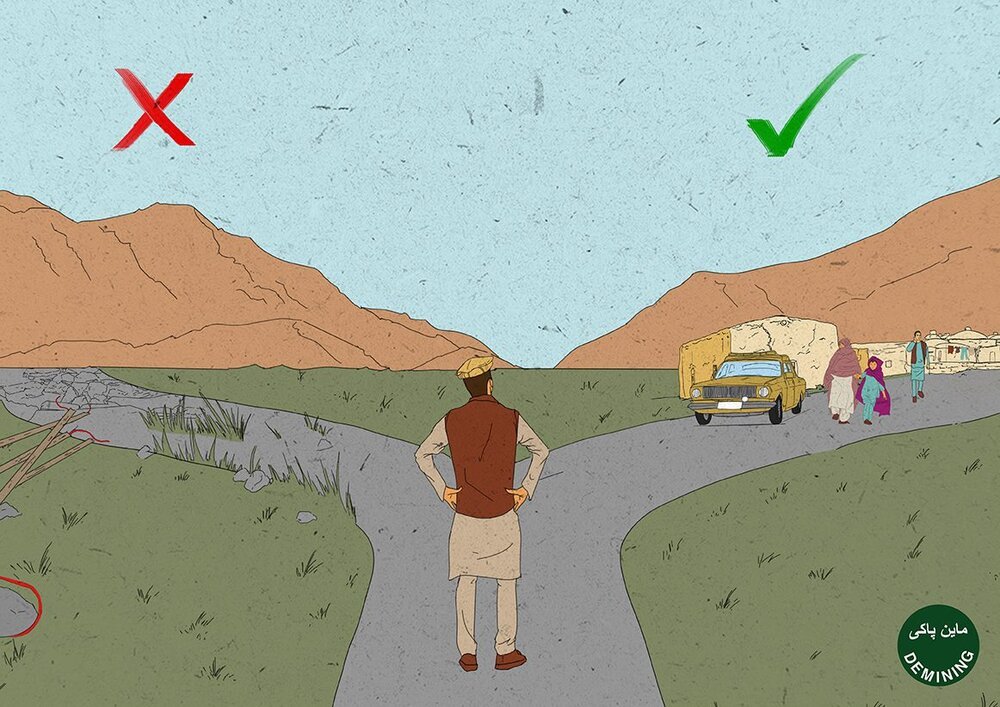
Explosive Risk: Measuring the Effectiveness of MRE Messaging Through Billboard and Radio
Client: UNMAS Afghanistan | Pillar: Social Development | Duration: 6 Months
Thematic Areas: Mine Risk Education
Services Provided: Monitoring and Evaluation


Challenge
Afghanistan is one of the most mined countries in the world, as 640,000 land mines have been dispersed since 1979
Over 31,000 casualties have been recorded between 1979 and 2018. In 2018 alone, 1,415 Afghan casualties were recorded. Children are also frequent victims and make up 80% of casualties
Many Afghans have low awareness of explosive hazards, engage in reckless behaviours that put them at risk, or are pressured by economic circumstances to intentionally engage in unsafe behaviours
Risk education has remained largely the same over the last two decades in Afghanistan and has failed to address the different social and behavioural drivers behind why individuals engage in unsafe behaviours
Our Social And Behavioural Insight
A sense of fatalism can be deeply engrained in parts of Afghanistan, and precludes a sense of personal agency when it comes to taking precautions against explosive hazards. Afghans may feel their destiny is not in their hands.
Current risk education materials are not aligned with SBC principles. They are too technical and focus on the danger of explosive hazards rather than engaging Afghans in an emotional, humane and relatable way.
Afghans may be overwhelmed by the “paradox of choice” when there are many behavioural options to choose from and it’s unclear what is the safe behaviour.
What We Did
Creative Ideation
MAGENTA designed new EORE materials for UNMAS to use their awareness sessions with Afghans, implemented across the country. These included:
6 billboards
1 notebook, including four sets of images
3 posters
Each set of materials included a unique creative concept
Testing
MAGENTA designed an evaluation to measure the impact of a radio and billboard campaign to promote awareness and safe behaviours through a baseline, midline and endline assessment
MAGENTA tested the billboard designs in FGDs and provided recommendations on how to improve their efficacy based on the results
MAGENTA conducted the evaluation to determine the impact of the billboards and radio ads on behaviours and awareness.Communications approach
Methodology - Evaluation
MAGENTA conducted an evaluation based on data collected at three different points in time:
Baseline data collected before the billboard and radio campaign began, between 8th – 21st March 2020
Midline data collected during the billboard and radio campaign, between 1st – 10th June 2020
Endline data collected at the end of the billboard and radio campaign, between the 6th – 16th August 2020
Each data collection exercise used quantitative phone surveys to measure the outcome-level indicators related to awareness, knowledge and behaviour change.
The evaluation used a quasi-random sample of 395 respondents. Results can be considered representative of the telephone-owning Afghan population at the 95% confidence level and with a margin of error of 5%.
Key Findings
The UNMAS radio and billboard campaign successfully reached a large proportion of Afghans in its target provinces
The radio messages had a higher reach than the billboards, and were more effective than billboards; respondents who were exposed to the radio ads saw their knowledge of explosive hazard risk increase more than respondents who saw the billboards.
Knowledge of the actions that can trigger the explosion of a mine remained stable over time; however, awareness of trigger actions was varied and men had higher knowledge of trigger actions than women.
Awareness of the correct mechanism to report mines/ERWs (through a government phone number) is low and has remained so since the beginning of the evaluation.
